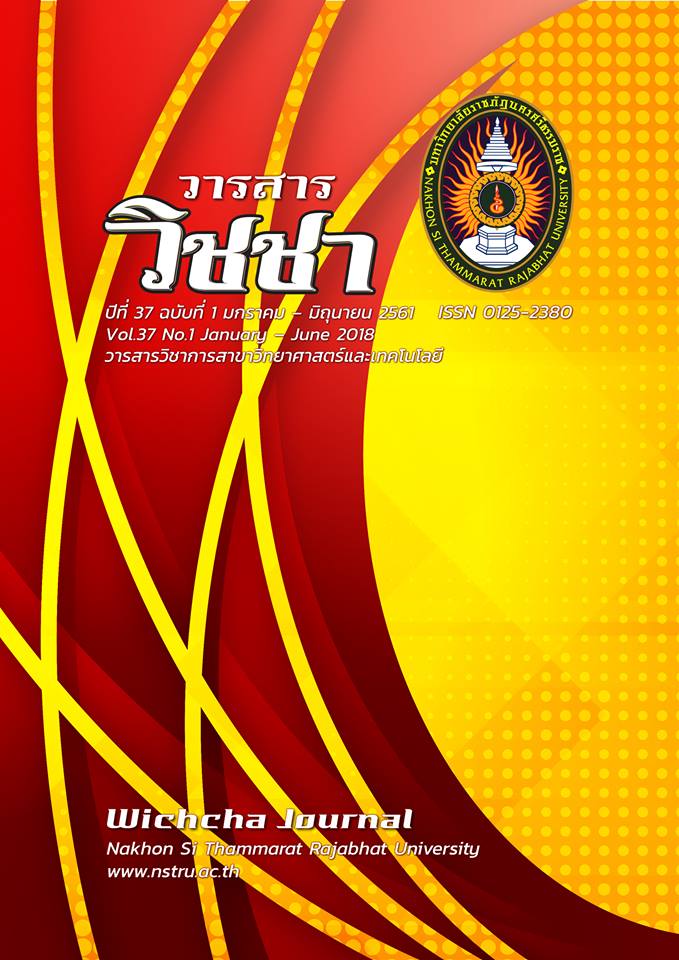การคัดแยกแบคทีเรียที่ผลิตฮีสทามีนและการวิเคราะห์คุณภาพผลิตภัณฑ์อาหารทะเลหมักในพื้นที่จังหวัดนครศรีธรรมราช
Main Article Content
บทคัดย่อ
จากการสุ่มเก็บตัวอย่างอาหารทะเลหมักในพื้นที่จังหวัดนครศรีธรรมราชจาก 6 อำเภอ อำเภอละ 5 ตัวอย่าง รวมทั้งสิ้น 30 ตัวอย่าง โดยร้อยละ 60 ของตัวอย่างเป็นผลิตภัณฑ์ไตปลาหมัก ร้อยละ 20 เป็นผลิตภัณฑ์กะปิ ร้อยละ 10 เป็นผลิตภัณฑ์ปลาเค็ม ร้อยละ 7 เป็นผลิตภัณฑ์หอยดอง และร้อยละ 3 เป็นผลิตภัณฑ์กุ้งส้ม ซึ่งสามารถคัดแยกเชื้อแบคทีเรียที่ผลิตฮีสทามีนได้ทั้งหมด 27 ไอโซเลท และเมื่อวิเคราะห์ปริมาณฮีสทามีนที่เชื้อสร้างขึ้นด้วยชุดวิเคราะห์หาปริมาณฮีสทามีน Veratox® พบว่าสามารถผลิตฮีสทามีนอยู่ในช่วง 35.49±0.01–41.29±0.02 ppm โดยไอโซเลทรหัส A18 A412 และ A51 สามารถสร้างฮีสทามีนได้ในปริมาณสูงอยู่ที่ระดับ 41.28±0.02 41.26±0.02 และ 41.29±0.02 ppm ตามลำดับ และเมื่อวิเคราะห์คุณภาพของผลิตภัณฑ์พบว่าค่า pH ของตัวอย่างทั้งหมดอยู่ในช่วงระหว่าง 4-7 โดยมีค่าเฉลี่ยอยู่ที่ 5.67±0.63 ในขณะที่ปริมาณเกลือของตัวอย่างทั้งหมดอยู่ในช่วงร้อยละ 5-30 โดยมีค่าเฉลี่ยอยู่ที่ร้อยละ 19.56±5.62 ปริมาณ TVB-N ในตัวอย่างทั้งหมดอยู่ในช่วง 200-1,300 mgN/100 g ตัวอย่าง โดยมีค่าเฉลี่ยอยู่ที่ 697.53±26.05 mgN/100 g ตัวอย่าง และปริมาณ TMA ในตัวอย่างทั้งหมดอยู่ในช่วง 14-150 mgN/100 g ตัวอย่าง โดยมีค่าเฉลี่ยอยู่ที่ 64.02±5.72 mgN/100 g ตัวอย่าง ทั้งนี้จากการวิเคราะห์ปริมาณฮีสทามีนโดยใช้ชุดทดสอบ HistaStripTM Test manual พบว่าในตัวอย่างรหัส B1 (ผลิตภัณฑ์ปลาเค็ม) และ E3 (ผลิตภัณฑ์ไตปลา) มีปริมาณฮีสทามีนสูงสุดอยู่ในช่วง 75 – 100 ppm เมื่อวิเคราะห์ปริมาณจุลินทรีย์ทั้งหมดพบว่าในตัวอย่างรหัส B3 (ผลิตภัณฑ์ปลาเค็ม) มีปริมาณจุลินทรีย์ทั้งหมดสูงที่สุดอยู่ที่ 8.8 x 106 CFU/g และพบเชื้อ Escherichia coli ในตัวอย่างผลิตภัณฑ์รหัส A2 A4 B3 และ F5
Article Details
เนื้อหาและข้อมูลในบทความที่ลงตีพิมพ์ในวารสารวิชชา มหาวิทยาลัยราชภัฏนครศรีธรรมราช ถือเป็นข้อคิดเห็นและความรับผิดชอบของผู้เขียนบทความโดยตรง ซึ่งกองบรรณาธิการวารสารไม่จำเป็นต้องเห็นด้วยหรือร่วมรับผิดชอบใด ๆ
บทความ ข้อมูล เนื้อหา รูปภาพ ฯลฯ ที่ได้รับการตีพิมพ์ในวารสารวิชชา มหาวิทยาลัยราชภัฏนครศรีธรรมราช ถือเป็นลิขสิทธ์ของวารสารวิชชา มหาวิทยาลัยราชภัฏนครศรีธรรมราช หากบุคคลหรือหน่วยงานใดต้องการนำข้อมูลทั้งหมดหรือส่วนหนึ่งส่วนใดไปเผยแพร่ต่อหรือเพื่อการกระทำการใด ๆ จะต้องได้รับอนุญาตเป็นลายลักษณ์อักษรจากวารสารวิชชา มหาวิทยาลัยราชภัฏนครศรีธรรมราชก่อนเท่านั้น
The content and information in the article published in Wichcha journal Nakhon Si Thammarat Rajabhat University, It is the opinion and responsibility of the author of the article. The editorial journals do not need to agree. Or share any responsibility.
References
ศิริรัตน์ ตันไสว. (2547). การศึกษาคุณสมบัติของแบคทีเรียกรดแลกติกทนร้อนที่ผลิตสารไบโอเจนิกเอมีนจากอาหารหมักไทย. วิทยานิพนธ์วิทยาศาสตรมหาบัณฑิต สาขาวิชาจุลชีววิทยา คณะวิทยาศาสตร์ มหาวิทยาลัยเกษตรศาสตร์, กรุงเทพฯ.
สำนักงานมาตรฐานผลิตภัณฑ์อุตสาหกรรม. (2546). มาตรฐานผลิตภัณฑ์ชุมชน. ค้นเมื่อ 3 พฤษภาคม 2560, จาก: https://tcps.tisi.go.th/public/StandardList.aspx.
A.O.A.C. (1995). Official Methods of Analysis of AOAC International. (16th ed). Arlington, Virginia: The association of Official Analytical Chemists.
A.O.A.C. (2000). Official Methods of Analysis of AOAC International. (17th ed). Arlington, Virginia: The association of Official Analytical Chemists.
Al-Busaidi M. A., Poulose Y., Khamis S. A., Adel K. A., Nashwa A. A., & Saoud H. A. (2011). Changes in scomberotoxin (histamine) and volatile amine (TVB-N) formation in Longtail Tuna (Thunnus tonggol) stored at different temperatures. Agricultural and Marine Sciences, 16, 13-22.
European Food Safety Authority. (2011). Scientific opinion on risk based control of biogenic amine formation in fermented foods. Panel on biological hazards. European Food Safety Authority Journal. 9(10), 2393-2487.
Gloria, M. B. A. (2005). Bioactive amines. In Hui, H. & Nollet, L. L. (Eds.). Handbook of food science, technology and engineering. (Vol. 4, pp. 1–38). USA: Marcel Dekker.
Hasegawa, H. (1987). Laboratory Manual on Analytical Methods and Procedures for Fish and Fish Products. In E. and H. Hasegawa (eds.). Marine Fisheries Research Department. Singapore.
Lin, C. S., Liu, F. L., Lee, Y. C., Hwang, C. C., & Tsai, Y. H. (2012). Histamine contents of salted seafood products in Taiwan and isolation of halotolerant histamine-forming bacteria. Food Chemistry, 131, 574-579.
Smolinska, S., Jutel, M., Crameri, R., & O’Mahony, L. (2014). Histamine and gut mucosal immune regulation. European Journal of allergy and Clinical Immunology, 69, 273–281.
Taylor, S. L. & Speckhard, M. W. (1983). Isolation of histamine-producing bacteria from frozen tuna. Marine Fisheries Review. 45, 35-39.
Tsai, Y. H., Lin, C. Y., Chang, S. C., Chen, H. C., Kung, H. F., & Wei, C. I. (2005). Occurrence of histamine and histamine-forming bacteria in salted mackerel in Taiwan. Food Microbiology, 22, 461-467.
Tsai, Y. H., Lin, C. Y., Chien, L. T., Lee, T. M., Wei, C. I., & Hwang, D. F. (2006). Histamine contents of fermented fish products in Taiwan and isolation of histamine-forming bacteria. Food Chemistry, 98, 64-70.
Wyder, M. T., Bachmann, H. P., & Puhan, Z. (1999). Role of selected yeasts in cheese ripening: an evaluation in foil wrapped Raclette Cheese. Lebensm. Wiss. u. Technol, 32, 333-343.
Zhai, H., Yang, X., Li, L., Xia, G., Cen, J., & Huang, H., et al. (2012). Biogenic amines in commercial fish and fish products sold in Southern China. Food Chemistry, 25, 303-308.

